Thin Ice: Monitoring Winter Lake Dynamics at Mohonk Lake
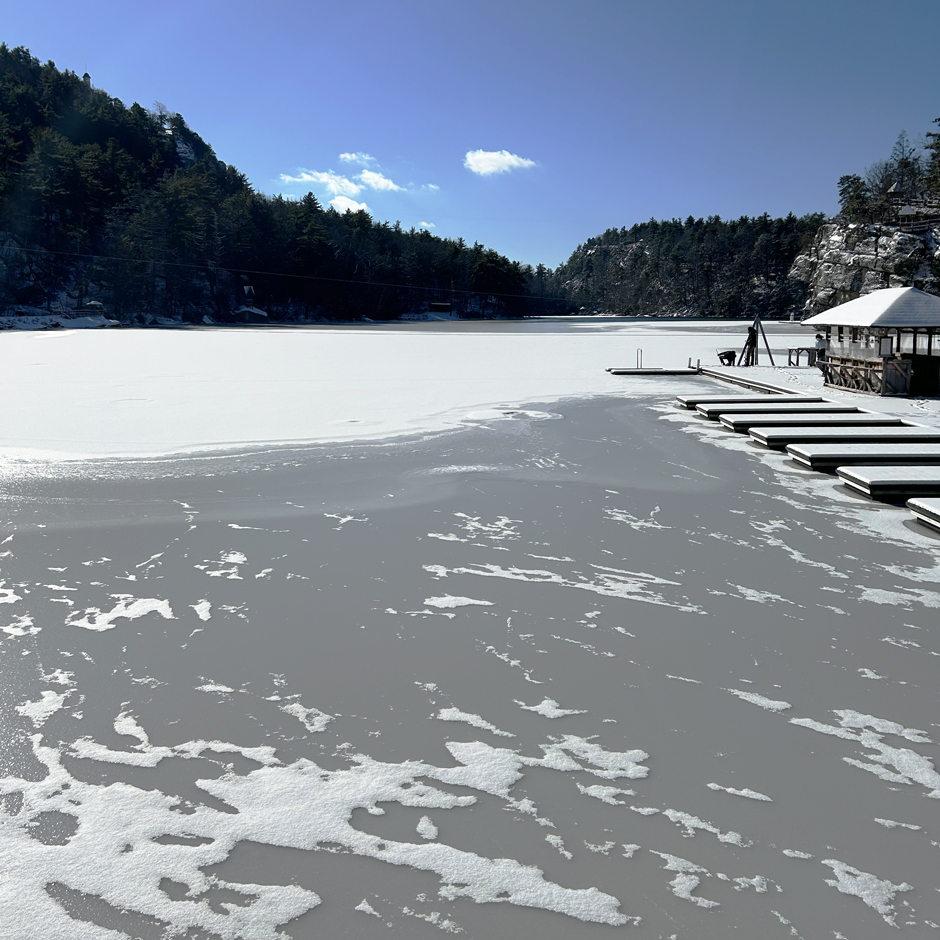 Photo of Mohonk Lake 75% ice covered on January 17, 2024. (Credit: David Richardson / SUNY New Paltz)
Photo of Mohonk Lake 75% ice covered on January 17, 2024. (Credit: David Richardson / SUNY New Paltz)Historically, water quality monitoring during the winter has been difficult and often avoided altogether—however, monitoring throughout the year can highlight the influence of various environmental stressors and track the changes systems undergo during the winter. In particular, long-term monitoring efforts in systems like Mohonk Lake can underline the effects of climate change and acid rain.
David Richardson, a professor of biology at the State University of New York (SUNY) at New Paltz, spends his time outside of the classroom monitoring the nearby watersheds. After getting his engineering undergraduate degree, Richardson realized he wasn’t interested in the typical job offerings and applied to an ecological science graduate program at the University of Maryland.
Richardson explains, “I really had an interest in doing environmental work and understanding the natural world and the problems that humans are causing—and how we can maybe help to solve or adapt to some of those changes.”
Finally, Richardson pursued a PhD in stream ecology, leading him to his post-doctoral work with the Lake Sunapee Protective Association (LSPA) at the Cary Institute of Ecosystem Studies. His time with the organization allowed him to work with an environmental monitoring buoy on a lake in New Hampshire and work with community members, lake associations, policymakers, local governments, and other scientists to utilize this data.
“It was a nice way to link, the science and technology on one side—and the citizens that are using the data in another way on the other side,” recalls Richardson
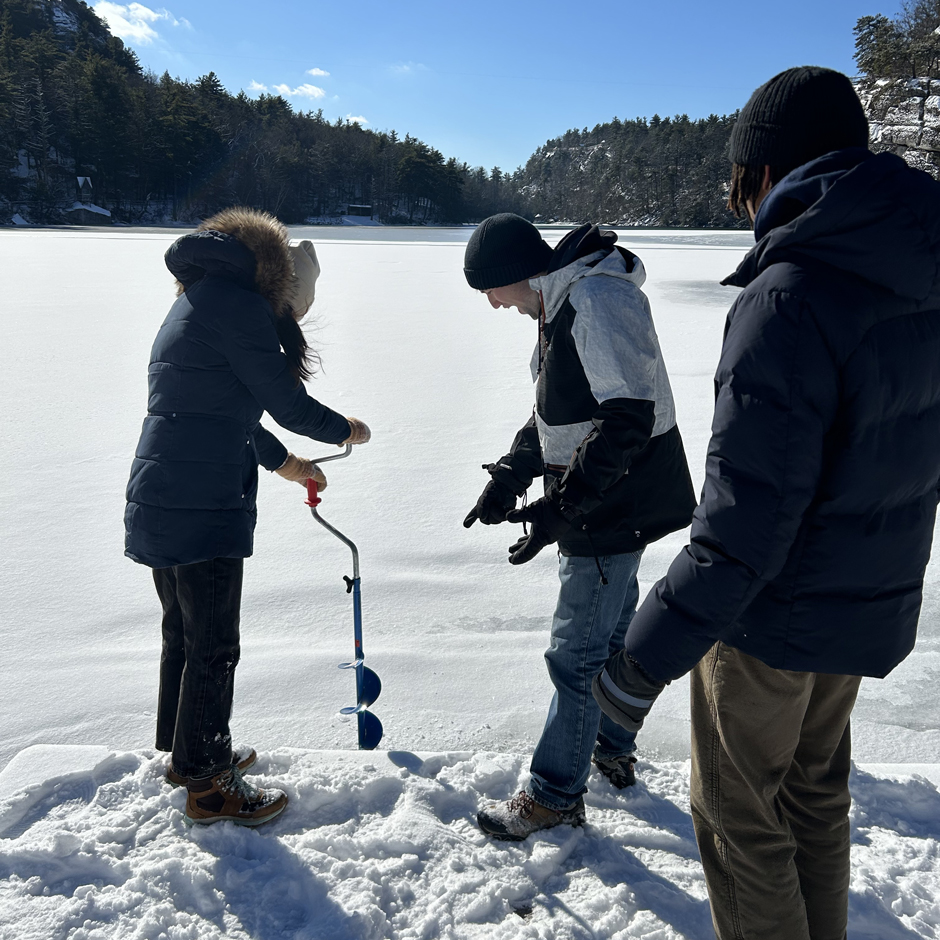
Delaney Long (Biology ’24) drills a hole in the ice at Mohonk Lake with a hand ice auger. Kian Gallagher (Biology ’24) and Dom Edwards (Biology ’24) look on as they prepare to sample the chemistry, biology, and physics of the lake under ice in winter conditions.
(Credit: David Richardson / SUNY New Paltz)
Data Collection for the Scientific and Public Good
This ideal of collecting data for the public and scientific good carried over into Richardson’s current work monitoring lakes located on Shawangunk Ridge. The watersheds are relatively small, but the lakes serve as indicators of acid rain and climate change.
He expands, “It’s a really unique ecosystem [. . .] It’s this ridge that sits at the base of the Catskills, but it’s an independent ridge—and there’s a whole bunch of lakes up on the ridge. And they’re almost like big bathtubs up on this ridge. In this area, they’re commonly called the sky lakes, because they just sit up on this ridge and reflect what’s going on in the watersheds that surround it.”
Most of Richardson’s research has focused on Mohonk Lake due to its proximity to the Mohonk Mountain House and has been monitored by the owners of the resort and spa.
“It’s one of the most unique datasets where they’ve been tracking daily weather since the 1800s. They’ve been tracking ice in the lake for over 90 years [. . .] After he retired, Daniel Smiley stayed around while his family ran the hotel, and he just made observations over the last 20 or 30 years of his life—things like, when animals were migrating or when plants were flowering,” observes Richardson.
He continues, “He recorded a fair bit of data from the lake, so we have a 40-plus year data set of Lake temperature and other facets of the lake to go along with the other long-term data.”
Around 2014, Richardson got involved in monitoring efforts at the hotel, and the data he’s collected has helped the business owners protect the nearby resources as well as support larger research questions and studies.
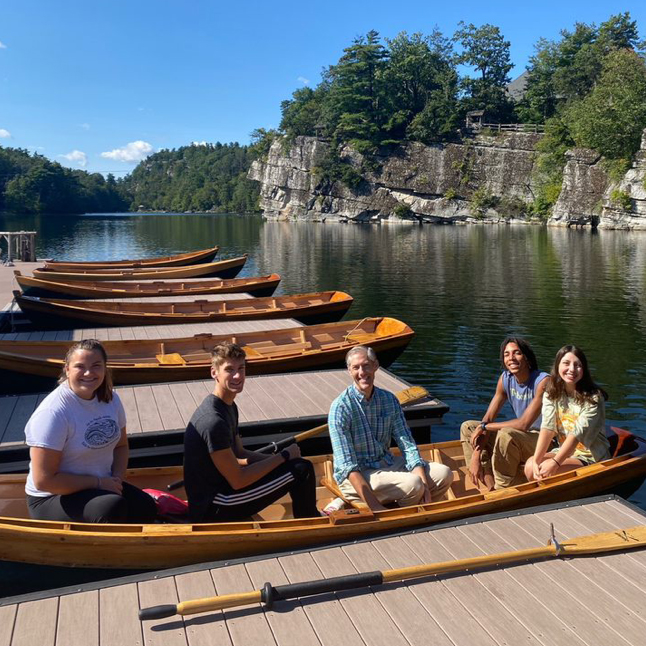
Left to right: Taylor Pazderski (senior Biology), Lucas Hoyt (senior Biology major), Dr. David Richardson, Dom Edwards (senior Biology major), and Alexia Leone (senior Biology major) during sampling at Mohonk Lake at the beginning of the fall 2023 semester. (Credit: David Richardson / SUNY New Paltz)
The Thin Ice Project
Richardson shares that collaborators across the country and regional partners like Global Lake Ecological Observatory Network (GLEON) are invested in monitoring Mohonk as his research focuses on understanding how the world is changing and how that’s affecting local ecosystems, whether it’s lakes or the organisms living within the lakes.
While floating around some ideas on how climate change has impacted lakes over time, Richardson and his colleagues focused on winter monitoring. While year-round monitoring is possible in some areas, various environmental variables can make monitoring difficult or impossible.
Still, Richardson and a host of other researchers across the U.S. wanted to establish a multi-lake study focusing on understanding how seasonal lake dynamics are changing, particularly during the winter. Isabella Oleksy at the University of Colorado in Boulder, Meredith Holgerson at Cornell University, Mindy Morales-Williams at the University of Vermont, and Rebecca North at the University of Missouri are all collaborators for this new project—aptly named the Thin Ice Project.
While all of the lakes involved in the study are located in different regions of the U.S., they represent a data distribution across various latitudes and winter dynamics. For example, some of the lakes included are covered in ice the entire winter, while others experience frequent freezes and thaws or no ice at all, representing a variety of lake conditions.
Because each lake is unique, each primary monitoring institution has developed a different approach to monitoring environmental conditions. For example, the University of Vermont team is conducting experiments in mesocosms where they can control ice conditions and the nutrients and organisms that are added.
Cornell is also taking a more experimental approach, using experimental ponds to test various environmental conditions and recording the changes they observe. In total, around 20 or 30 lakes are being monitored as part of this larger project.
Richardson elaborates, “So we’re going to do some at a broader scale through our GLEON community where we measure some data in the summer and some in the winter, to really look at a much broader scale.
And then we have a small subset of five different lakes that are going to be our model lakes and will have real-time sensors and data buoys.”
The data can be used to understand changes at a daily scale, sub-daily scale, and up to a seasonal scale. Additionally, the data will be used to design mechanistic dynamic models that allow users to run various climate scenarios and forecast the lake conditions.
Richardson’s role in the project is to help oversee monitoring efforts and use the data to run and calibrate the climate models. He is also tasked with all of the field sampling and maintenance of the monitoring equipment at Mohonk.
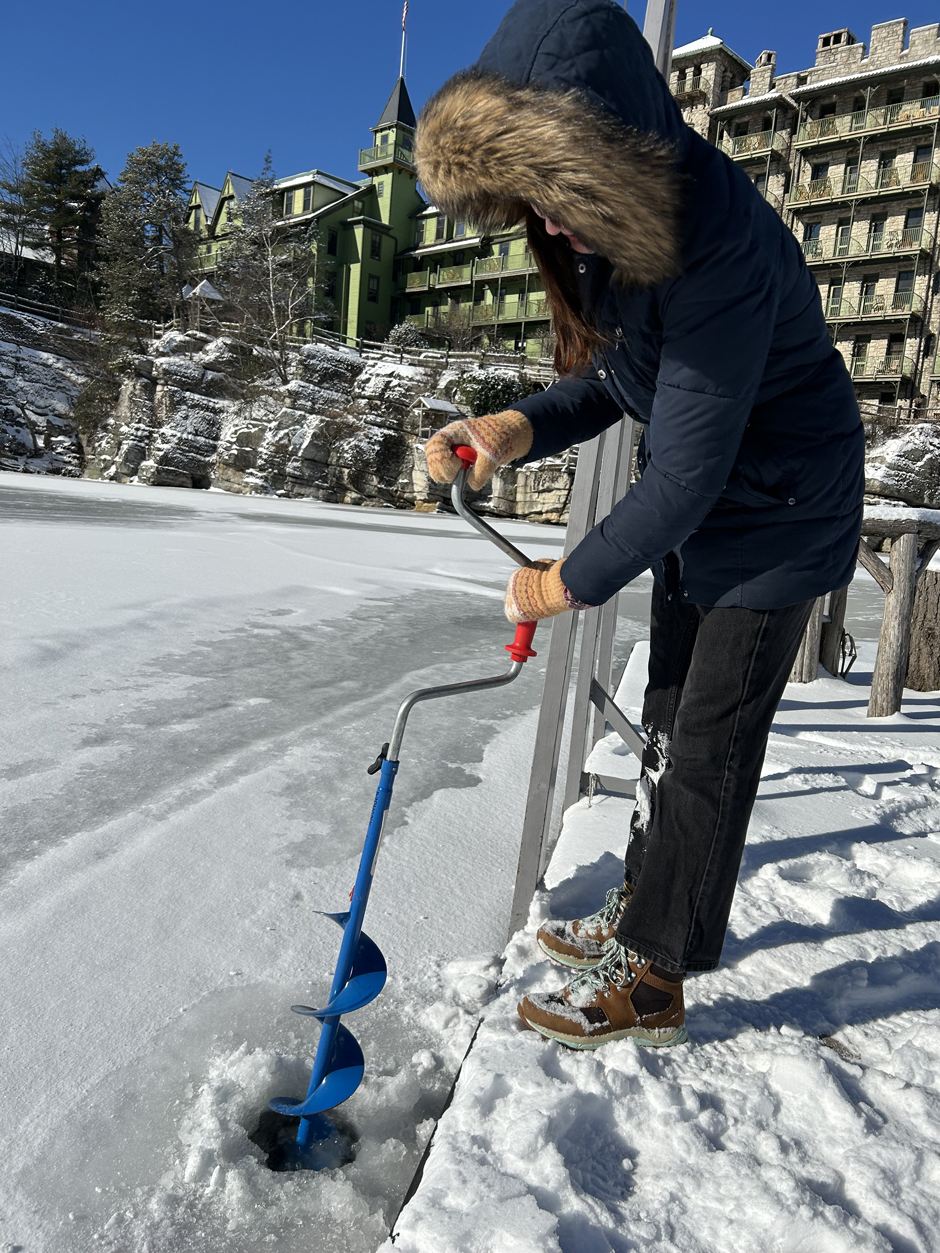
Delaney Long (Biology ’24) is drilling a hole in the ice at Mohonk Lake with the Mohonk Mountain House in the background. She is checking the thickness of the ice. The ice was ~7cm (< 3 inches) thick at this location, but there was open water at the south end of the lake despite the frigid temperatures. (Credit: David Richardson / SUNY New Paltz)
Working Alongside Stakeholders to Monitor Mohonk Lake
Managing such a large project can present various challenges, and Richardson’s work specifically is unique in that his major partner for Mohonk is a for-profit organization.
Richardson explains, “They are amazing collaborators, but obviously, they have different overall missions. Maintaining their resources for guest use and enjoyment is supported by what we, as scientists, do but are not exclusive to our science focus—and we must work with the hotel to make sure that we are not interfering with their guests, employees, and the people that use the lake for recreation. It can be challenging to monitor the lake, but it also comes with benefits like access and infrastructure.”
There are also environmental challenges to monitoring throughout the winter. In previous work with the LSPA, Richardson has left buoys deployed during the winter and has had mixed results. One year, the buoy froze into the lake and was deployed the whole winter with no problems—the following year, the buoy was crushed by the ice and froze underneath.
For the current project, the sensors will be deployed from a dock on Mohonk Lake, which Richardson believes will be a bit more reliable, as it provides a physical structure for the sensors, and the power that runs to the dock provides a readily available energy source. Still, Richardson will be helping his collaborators develop solutions to winter-time monitoring.
For Mohonk, a NexSens data logger drives everything. A TS210 themperature String with thermistors placed every meter along the line measures water temperature at different depths. A Lufft WS501 weather station collects weather data, allowing Richardson to spot trends between weather conditions and water quality.
Additionally, a YSI EXO2 sonde will also deployed in order to gather real-time data. The sondes allow project managers to monitor various parameters depending on the needs of the lake. For Mohonk, dissolved oxygen, pH, conductivity, and temperature will be the focus. Collectively, each of the lakes will be monitoring chlorophyll and phycocyanin. A LI-COR 190 and LI-COR 200 will also be used to measure light conditions above and below the water surface.
Richardson elaborates, “We want an idea of what happens when the lake freezes and then melts, or accumulates snow on the ice. That has implications for the light distribution in the lake and how the algae that live in the lake are getting the light that will drive their photosynthesis [. . .] I think that’s going to be something that is kind of new, and we’re going to try and leave them out over the winter.”
He continues, “We want to know more than just how the ice is attenuating the light but also what is being experienced by the algae that are living there. And we might see changes especially as lakes, freeze and melt multiple times or experience ice-free winters.”
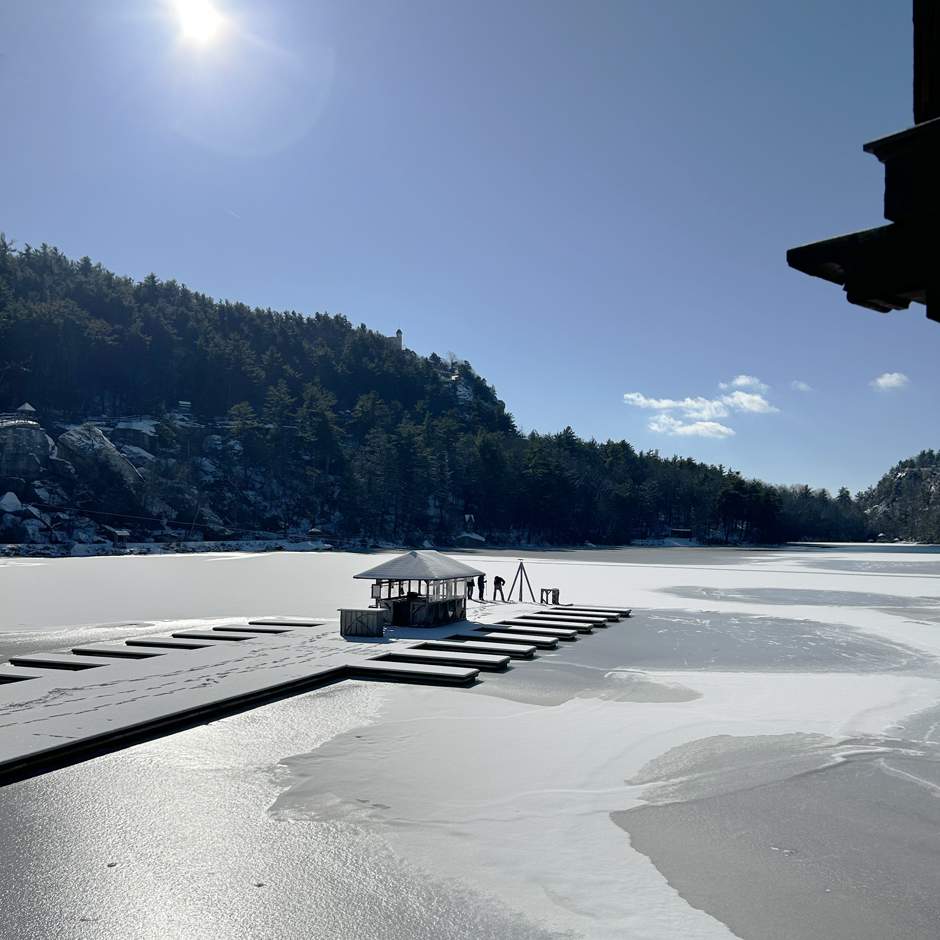
Photo of Mohonk Lake 75% ice covered on January 17, 2024. (Credit: David Richardson / SUNY New Paltz)
Conclusion
Ultimately, the Thin Ice Project will gather a wide variety of data that can be referenced in future studies and should shed some light on winter dynamics, a part of the year that is often neglected. The project also perfectly captures some of the most rewarding components of Richardson’s work.
SUNY is a predominantly undergraduate institution, and as such, Richardson works with a team of undergraduates to gather high-quality data. Because the project combines fieldwork and technology, Richardson has been able to include a variety of students.
“I’ve had a chance to work with computer science undergraduates. So, they get really excited about the technology and engineering—as well as the data aspect—and thinking about connecting real-time data to the web so that people can see it. It’s been a really fun experience from that perspective—to be able to let the students get involved with high-quality data collection,” explains Richardson.
The growth of real-time monitoring technology and the implementation of such instruments has also been rewarding. The rise of real-time technology has brought with it higher-frequency data that better illustrates conditions over time in the monitored region.
“One of my favorite examples to talk to my students about is thinking about [. . .] the traditional aspect of environmental monitoring where you go out once a month, or you go out once every few months, or you out go out only in the summer—and my analogy is thinking about measuring your temperature. If you only measure your temperature once in a while, then you never know when you are healthy or when something is wrong, and you might be sick. Using high-frequency monitoring with sensors and setups from Fondriest will allow us to understand the rhythms and health of lakes 24 hours a day all year,” states Richardson.
Beyond the local impact of the project on Richardson and his students, lake research is occurring across the world, and the data collected by the Thin Ice Project will be used by other researchers to support future data and observations.
*This is part one of a two-part story on the Thin Ice Project. To read part one, click here
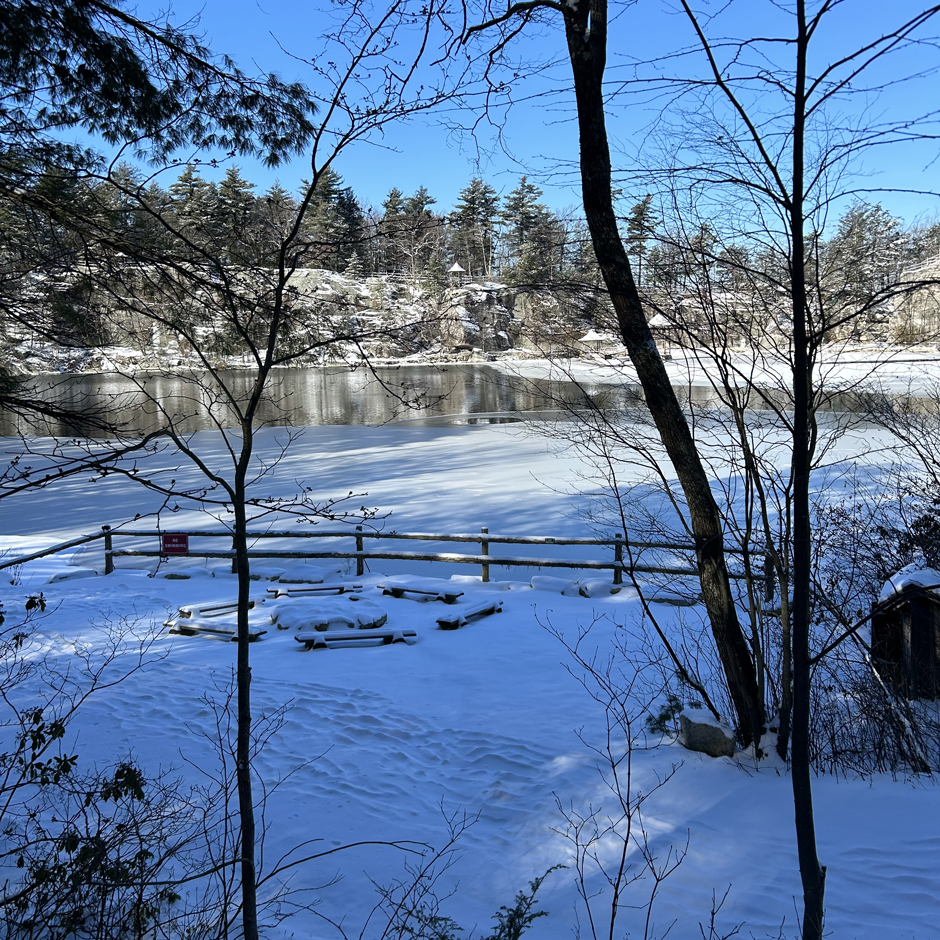
Open water portion of Mohonk Lake on January 17, 2024. (Credit: David Richardson / SUNY New Paltz)




Pingback: Kiyoko Yokota earns NSF Research Opportunity Award – The Oneonta Bulletin | SUNY Oneonta
Pingback: Research Brief: Understanding the Influence of Changing Ice Penology on Under-Ice Temperature Dynamics - Lake Scientist